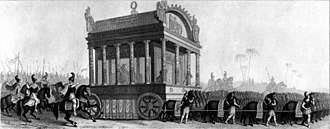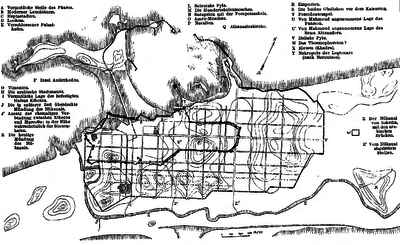Tomb of Alexander the Great
The location of the tomb of Alexander the Great is an enduring mystery. Shortly after Alexander's death in Babylon, the possession of his body became a subject of negotiations between Perdiccas, Ptolemy I Soter, and Seleucus I Nicator.[1] According to Nicholas J. Saunders, while Babylon was the "obvious site" for Alexander's resting place, some favored interring the ruler in the Argead burial at Aegae, modern Vergina.[2] Aegae was one of the two originally proposed resting places, according to Saunders, the other being Siwa Oasis and in 321 BC Perdiccas presumably chose Aegae.[3] The body, however, was hijacked en route by Ptolemy I Soter. According to Pausanias and the contemporary Parian Chronicle records for the years 321–320 BC, Ptolemy initially buried Alexander in Memphis. In the late 4th or early 3rd century BC, during the early Ptolemaic dynasty, Alexander's body was transferred from Memphis to Alexandria, where it was reburied.
.jpg)

The so-called Alexander Sarcophagus, unrelated to Alexander's body and once thought to be the sarcophagus of Abdalonymus, is now believed to be that of Mazaeus, a Persian governor of Babylon.[4]
Background
According to Quintus Curtius Rufus and Justin, Alexander asked shortly before his death to be interred in the temple of Zeus Ammon at Siwah Oasis.[5] Alexander, who requested to be referred to and perceived as the son of Zeus Ammon, did not wish to be buried alongside his actual father at Aegae.[5] Alexander's body was placed in a coffin of "hammered gold", according to Diodorus, which was "fitted to the body". The coffin is also mentioned by Strabo and Curtius Rufus (subsequently, in 89–90 BC the golden coffin was melted down and replaced with that of glass or crystal[6]).
Alexander's wish to be interred in Siwa was not honored. In 321 BC, on its way back to Macedonia, the funerary cart with Alexander's body was hijacked in Syria by one of Alexander's generals, Ptolemy I Soter. In late 322 or early 321 BC Ptolemy diverted the body to Egypt where it was interred in Memphis, the center of Alexander's government in Egypt. While Ptolemy was in possession of Alexander's body, Perdiccas and Eumenes had Alexander's armor, diadem and royal scepter.[7]
According to Plutarch, who visited Alexandria, Python of Catana and Seleucus were sent to a serapeum to ask the oracle whether Alexander's body should be sent to Alexandria and the oracle answered positively.[8] In the late 4th or early 3rd century BC Alexander's body was transferred from the Memphis tomb to Alexandria for reburial[9] (by Ptolemy Philadelphus in c. 280 BC, according to Pausanias). Later Ptolemy Philopator placed Alexander's body in Alexandria's communal mausoleum.[9] The mausoleum was called the Soma or Sema, which means "body" in Greek. By 274 BC Alexander was already entombed in Alexandria.[10] The Tomb of Alexander became the focal point for the Ptolemaic cult of Alexander the Great.
Historical attestations
_visiting_Alexander's_tomb_in_Alexandria_by_Sebastien_Bourdon_(c._1643%2C_Louvre).jpg)
In 48 BC Alexander's tomb was visited by Caesar.[6] To finance her war against Octavian, Cleopatra took gold from the tomb.[11] Shortly after the death of Cleopatra, Alexander's resting place was visited by Octavian, who is said to have placed flowers on the tomb and a golden diadem upon Alexander's head.[9] According to Suetonius, Alexander's tomb was then partially looted by Caligula, who reportedly removed his breastplate. In AD 199 Alexander's tomb was sealed up by Septimius Severus during his visit to Alexandria.[6] Later, in 215 some items from Alexander's tomb were relocated by Caracalla.[6] According to chronicler John of Antioch, Caracalla removed Alexander's tunic, his ring, his belt with some other precious items and deposited them on the coffin.
When John Chrysostom visited Alexandria in AD 400, he asked to see Alexander's tomb and remarked, "his tomb even his own people know not".[11] Later authors, such as Ibn 'Abd al-Hakam (b. AD 803), Al-Masudi (b. AD 896) and Leo the African (b. 1494), report having seen Alexander's tomb.[9] Leo the African, who visited Alexandria as a young man, wrote: "In the midst of the ruins of Alexandria, there still remains a small edifice, built like a chapel, worthy of notice on account of a remarkable tomb held in high honor by the Mahometans; in which sepulchre, they assert, is preserved the body of Alexander the Great... An immense crowd of strangers come thither, even from distant countries, for the sake of worshipping and doing homage to the tomb, on which they likewise frequently bestow considerable donations".[12] George Sandys, who visited Alexandria in 1611, was reportedly shown a sepulchre there, venerated as the resting place of Alexander.[13]
Present location

.svg.png)
The Egyptian Supreme Council for Antiquities has officially recognized over 140 search attempts for Alexander's tomb.[9] Mahmoud el-Falaki (1815–1885), who compiled the map of ancient Alexandria, believed Alexander's tomb is in the center of Alexandria, at the intersection of the Via Canopica (modern Horreya Avenue) and the ancient street labeled R5.[14] Since then several other scholars such as Tasos Neroutsos, Heinrich Kiepert and Ernst von Sieglin placed the tomb in the same area.[14] In 1850 Ambroise Schilizzi announced the discovery of alleged Alexander's mummy and tomb inside the Nabi Daniel Mosque in Alexandria.[15] Later, in 1879 a stone worker accidentally broke through the vaulted chamber inside the basement of that mosque. Some granite monuments with an angular summit were discerned there, but the entrance was then walled up and the stone worker was asked not to disclose the incident. (The image on a Roman lamp in the National Museum of Poznań and others at the British Museum and the Hermitage Museum are interpreted by some scholars as showing Alexandria with the Soma Mausoleum pictured as a building with a pyramidal roof.)[8] In 1888 Heinrich Schliemann attempted to locate Alexander's tomb within the Nabi Daniel Mosque, but he was denied permission to excavate.[15]
In 1993, Triantafyllos Papazois developed the theory that it is not Philip II of Macedon who is buried in the royal tomb II at Vergina, Greece, but it is Alexander the Great together with his wife Roxanne, while his son Alexander IV is buried in tomb III.[16] Also based on the ancient historical sources he came to the conclusion that the breastplate, the shield, the helmet and the sword found in tomb II, belong to the armor of Alexander the Great.[17]
In 1995, Greek archaeologist Liana Souvaltzi announced that she identified one alleged tomb in Siwah with that of Alexander. The claim was put in doubt by the then general secretary of the Greek Ministry of Culture, George Thomas, who said that it was unclear whether or not the excavated structure is even a tomb.[18] Thomas and members of his team said that the style of the excavated object was not, as Souvaltzi contended, Macedonian, and that the fragments of tablets they were shown did not support any of the translations provided by Souvaltzi as proof of her finding.[18]
According to one legend, the body lies in a crypt beneath an early Christian church.[19]
In a 2011 episode of the National Geographic Channel television series Mystery Files, Andrew Chugg claimed that Alexander the Great's body was stolen from Alexandria, Egypt, by Venetian merchants who believed it to be that of Saint Mark the Evangelist. They smuggled the remains to Venice, where they were then venerated as Saint Mark the Evangelist in the Basilica Cattedrale Patriarcale di San Marco.[20][21][22]
The 2014 discovery of a large Alexander-era tomb at Kasta Tomb in Amphipolis in the region of Macedonia, Greece,[23] has once again led to speculation about Alexander's final resting place. Some have speculated that it was built for Alexander but never used due to Ptolemy I Soter having seized the funeral cortege. They suggest that the Roman Emperor Caracalla, a great admirer of Alexander, may have had him re-interred in Amphipolis in the late second century AD. However, only future excavation at Amphipolis will reveal if there is any truth in the suggestion. In November 2014, a skeleton was discovered within the tomb,[24] and its full examination is expected to last a few months in order to determine the characteristics of the deceased person in the effort to identify it. However, the excavation team, based on findings unearthed at the site, argued that the tomb was a memorial dedicated to the close friend of Alexander the Great, Hephaestion.[25][26]
In 2019, a marble statue of Alexander was found by a Greek archaeologist, Calliope Limneos-Papakosta, who has been excavating for 14 years in the Shallalat Gardens, which occupies the ancient royal quarter in Alexandria.[27]
See also
- Royal Mausoleum of Mauretania
- Tomb of Genghis Khan - also unknown
Notes
- Saunders 2007, p. 34
- Saunders 2007, p. 35
- Saunders 2007, p. 38
- Alexander the Great at War: His Army - His Battles - His Enemies. Osprey Publishing. 2008. p. 123. ISBN 1846033284.
- Lauren O'Connor (2008). "The Remains of Alexander the Great: The God, The King, The Symbol". Constructing the Past. Retrieved 1 November 2013.
- Saunders 2007, p. x
- Saunders 2007, p. 41
- "Ancient sources". Hellenic Electronic Center Portal. Retrieved 1 November 2013.
- Robert S. Bianchi. "Hunting Alexander's Tomb". Archaeology.org. Retrieved Aug 21, 2011.
- Saunders 2007, p. 53
- "Alexander the Great, King of Macedon". Archaeology. July 16, 2013. Retrieved August 12, 2016.
- Madden 1851, p. 138
- Madden 1851, p. 137
- "Where is Alexander Buried?". Hellenic Electronic Center. Retrieved 1 November 2013.
- Saunders 2007, p. xii
- Saunders, Alexander's tomb, p.187
- Τ.Παπαζώης, Ο Μέγας Αλέξανδρος με την οικογένεια του είναι θαμμένοι στους βασιλικούς τάφους ΙΙ και ΙΙΙ της Βεργίνας, 2017
- "No evidence seen of Alexander's tomb, Greeks say". The Baltimore Sun. February 6, 1995. Retrieved 1 November 2013.
- "Alexander's death riddle is 'solved'". BBC. June 11, 1998. Retrieved Aug 21, 2011.
- "Mystery Files – The Disappearance of Alexander's Tomb". Metacafe.
- "Mystery Files: Alexander the Great, Wednesday, June 29". The Sydney Morning Herald.
- "About Mystery Files Show – National Geographic Channel – UK". National Geographic Channel – Videos, TV Shows & Photos – UK.
- Giorgos Christides (22 September 2014). "Greeks captivated by Alexander-era tomb at Amphipolis". BBC. Retrieved 2 April 2015.
- Greek Government - Ministry of Culture and Sports - 12th November 2014 Press Release (in Greek)
- "Archaeologist claims opulent grave in Greece honored Alexander the Great's best friend". US News. 30 September 2015.
- "Hephaestion's Monogram Found at Amphipolis Tomb". Greek Reporter. 30 September 2015.
- "New clues to the lost tomb of Alexander the Great discovered in Egypt". National Geographic. 28 February 2019.
References
- Saunders, Nicholas (2007). Alexander's Tomb: The Two-Thousand Year Obsession to Find the Lost Conqueror. Basic Books. ISBN 0465006213.CS1 maint: ref=harv (link)
- Madden, Richard (1851). The Shrines and Sepulchres of the Old and New World. Newby.CS1 maint: ref=harv (link)